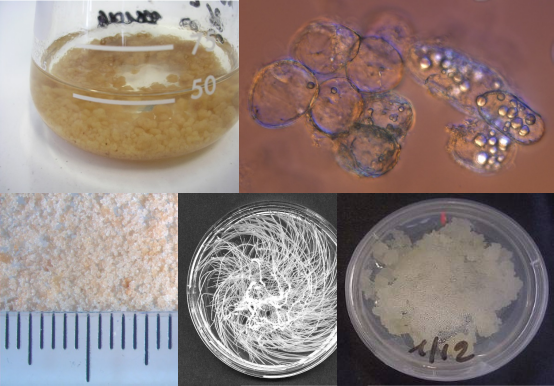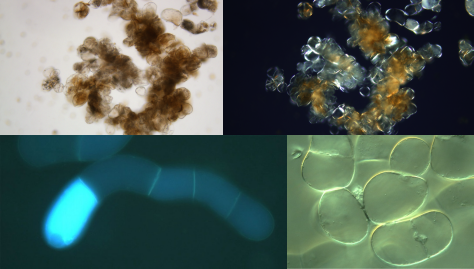Plant biotechnology
|
Plants are a rich source of natural products that pharmaceutical, cosmetic and food companies explore to develop new drugs, neutraceuticals, perfumes, antioxidants, food additives and various other commodities. Supply of plant materials in nature is regularly problematic and may limit the development of innovative products into commercial success. Many tropical plants are rare in nature, present in limited and inaccessible area, and harvest of essential plant parts (bark, rhizome, roots) threatens conservation of the natural resources. Wild temperate forests are as well a rich source of fine products threatens by climate changes and deforestation. |
 |
 Plant Cell Biotechnology offers alternative system for production of natural products, plant extracts and plant cells. Plant cell suspensions are amenable to large scale culture of dedifferentiated cells accumulating many natural products. Plant tissue culture allows rapid propagation of plant vegetative tissue as a source of healthy stocks for field propagation and for conservation of genetic resources. Hairy root cultures are immortalized roots with continuous growth habits that has the potential to supplies many natural products only found in underground plant parts.
 |
The EA2106 BBV research unit has a long expertise in the development of plant cell biotechnology, in particular from tropical and medicinal plants. Many new cell lines are established from new species for selection of best producing cell lines. Production of natural products is often inhibited by plant growth regulators used for plant cell multiplication (auxin). Optimization of plant growth regulators with respects to metabolic elicitors (sugars, cytokinin, methyljasmonate, ethylene, fungi cell wall fractions) allows stimulation of natural products accumulation. We develop new plant cell platform and improves natural product yields in collaborative research program with industrial partners. The laboratory is fully equipped for plant cell and tissue cultures, with air-filtered facilities for axenic manipulation of plant material and controlled environment growth chambers and shakers. |
|
Selected industrial partnership: “ELIXIR Project” : Production of high-value natural products by plant cell culture technology (2011-2014) Industrial partners : DIANA Group/Symrise (Diana Plant Sciences), Pierre Guérin SA Academic partners : Université de Bourgogne (Laboratoire Génie des Procédés Microbiologiques et Alimentaires), Université de Tours (BBV) Financial support : Oséo/BPI France |
|
Â
Contact: Benoît Saint-Pierre, Joël Crèche
Publications:
|
Etsè, K. D., Aïdam, A. V., Melin, C., Blanc, N., Oudin, A., Courdavault, V., Creche, J. & Lanoue, A. (2014). Optimized genetic transformation of Zanthoxylum zanthoxyloides by Agrobacterium rhizogenes and the production of chelerythrine and skimmiamine in hairy root cultures. Eng Life Sci 14, 95–99. Etsè, K. D., Aïdam, A. V., de Souza, C., Crèche, J. & Lanoue, A. (2011). In vitro propagation of Zanthoxylum zanthoxyloides Lam., an endangered African medicinal plant. Acta Bot Gall 158, 47–55. Senoussi, M.M., Bassa, N. & Crèche, J. (2009). Impact of hypoxia on the growth and alkaloid accumulation in Catharanthus roseus cell suspension. Acta Physiol Plant 31, 359-62. Guillon, S., Trémouillaux-Guiller, J., Pati, P.K. & Gantet, P. (2008). Hairy roots: a powerful tool for plant biotechnological advances. In Bioactive Molecules and Medicinal Plants, pp. 271-283. Edited by K.G. Ramawat & J.-M . Mérillon, Springer. Guillon, S., Gantet, P., Thiersault, M., Rideau, M. & Trémouillaux-Guiller (2008). Hairy Roots of Catharanthus roseus: Efficient Routes to Monomeric Indole Alkaloid Production. In Bioactive Molecules and Medicinal Plants, pp. 285-295. Edited by K.G. Ramawat & J.-M . Mérillon, Springer. Guillon, S., Trémouillaux-Guiller, J., Pati, P.K., Rideau, M. & Gantet, P. (2006). Harnessing the potential of hairy roots: dawn of a new era. Trends Biotechnol 24, 403-9. Guillon, S., Trémouillaux-Guiller, J., Pati, P.K., Rideau, M. & Gantet P. (2006). Hairy root research: recent scenario and exciting prospects. Curr Opin Plant Biol 9, 341-6. Senoussi, M.M., Bassa, N., Crèche, J., Rideau, M. & Chénieux J.-C. (2004). Effects of hypoxia, loganin and BAP on ajmalicine accumulation in cells of Catharanthus roseus (Vinca rosea) In vitro. Damascus University Journal for BASIC SCIENCES 20, 9-17. Ayadi, R. & Trémouillaux-Guiller, J. (2003). Root formation from transgenic calli of Ginkgo biloba. Tree Physiol 23, 713-8. Couillerot, E., Caron, C., Trentesaux, C., Chénieux, J.-C. & Audran, J.-C. (2000). Genetic Transformation of Fagara zanthoxylaides Lam,(Rutaceae). In Biotechnology in Agriculture and Forestry, Vol. 44, pp. 115-124. Edited by Y.P.S. Bajaj. Springer-Verlag Berlin Heildelberg. |
